What’s location-based marketing?
Published on September 11, 2025/Last edited on September 11, 2025/15 min read
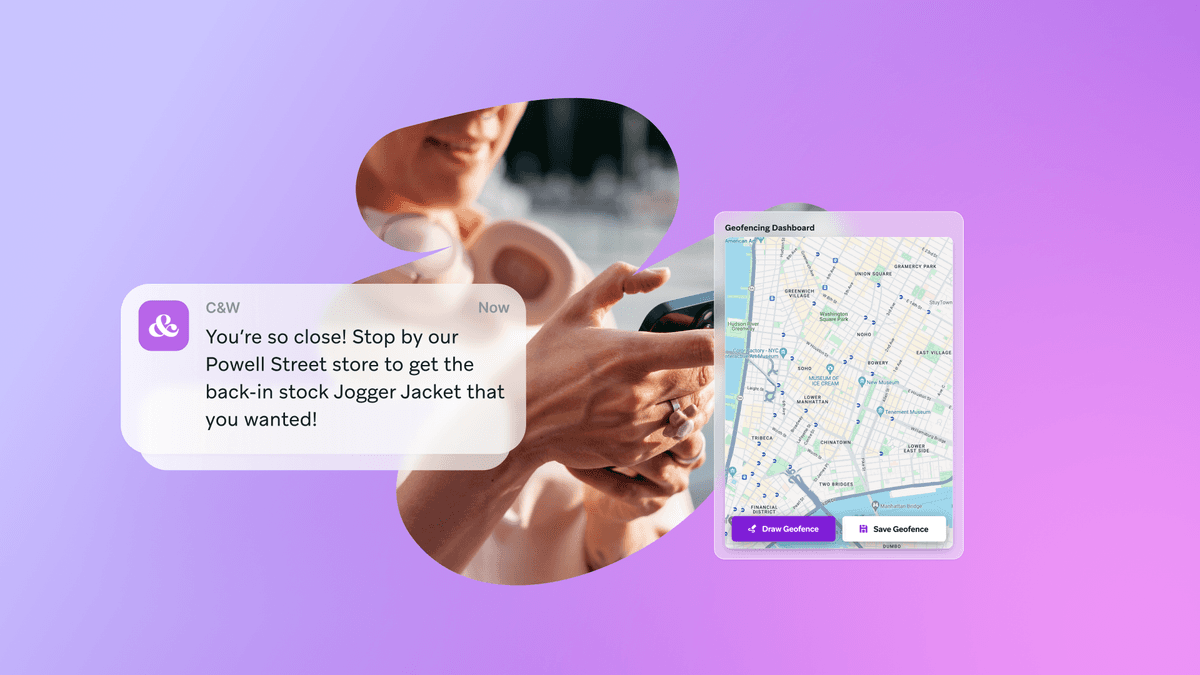

Team Braze
You’re walking past your favorite coffee shop when your phone buzzes—a push notification offers 20% off if you order in the next 30 minutes. You weren’t planning to stop, but now you’re tempted.
That’s location-based marketing in action, and a perfect example of how location-based advertising turns proximity into a personalized, real-time experience. By using location data to tailor outreach in the moment, brands can make campaigns hyper-relevant, boosting conversions by up to 27%.
71% of consumers expect personalized experiences from brands, and as we naturally pay more attention to what’s happening nearby—whether it’s a local game, an event, or a new restaurant—it’s no surprise that location has become one of the most powerful tools in a marketer’s toolkit.
In this guide, we’ll cover:
- Definition and key concepts of location-based marketing
- Types of location-based marketing strategies
- How location-based marketing works in practice
- Benefits of location-based marketing for customer engagement
- Real-world examples of location-based advertising campaigns
- Privacy considerations and platform changes in location-based marketing
- Best practices for implementing location-based marketing
- How Braze supports location-based marketing campaigns
- Checklist for location-based marketing success
- Final thoughts on location-based marketing
- Location-based marketing FAQs
Definition and key concepts of location-based marketing
Location-based marketing is when brands tailor their outreach based on the current physical location of each messaging recipient. Brands look at how customers move around in the real world and use that movement to trigger digital experiences. By identifying where a customer is in real time, marketers can deliver messages, offers, and experiences that feel directly relevant to that person, in that moment.
This approach uses location data from sources such as mobile devices, GPS, Wi-Fi signals, Bluetooth beacons, or third-party enrichment services to target those within a specific area.
Types of location-based marketing strategies
There are several common types of location-based marketing, each suited to different goals, audiences, and contexts.
1. Geo-targeting
Geo-targeting is the practice of detecting a user’s location and delivering tailored messages, whether that’s an ad, an email, or a push notification, based on where they are. It’s a direct way to make your outreach feel immediately relevant.
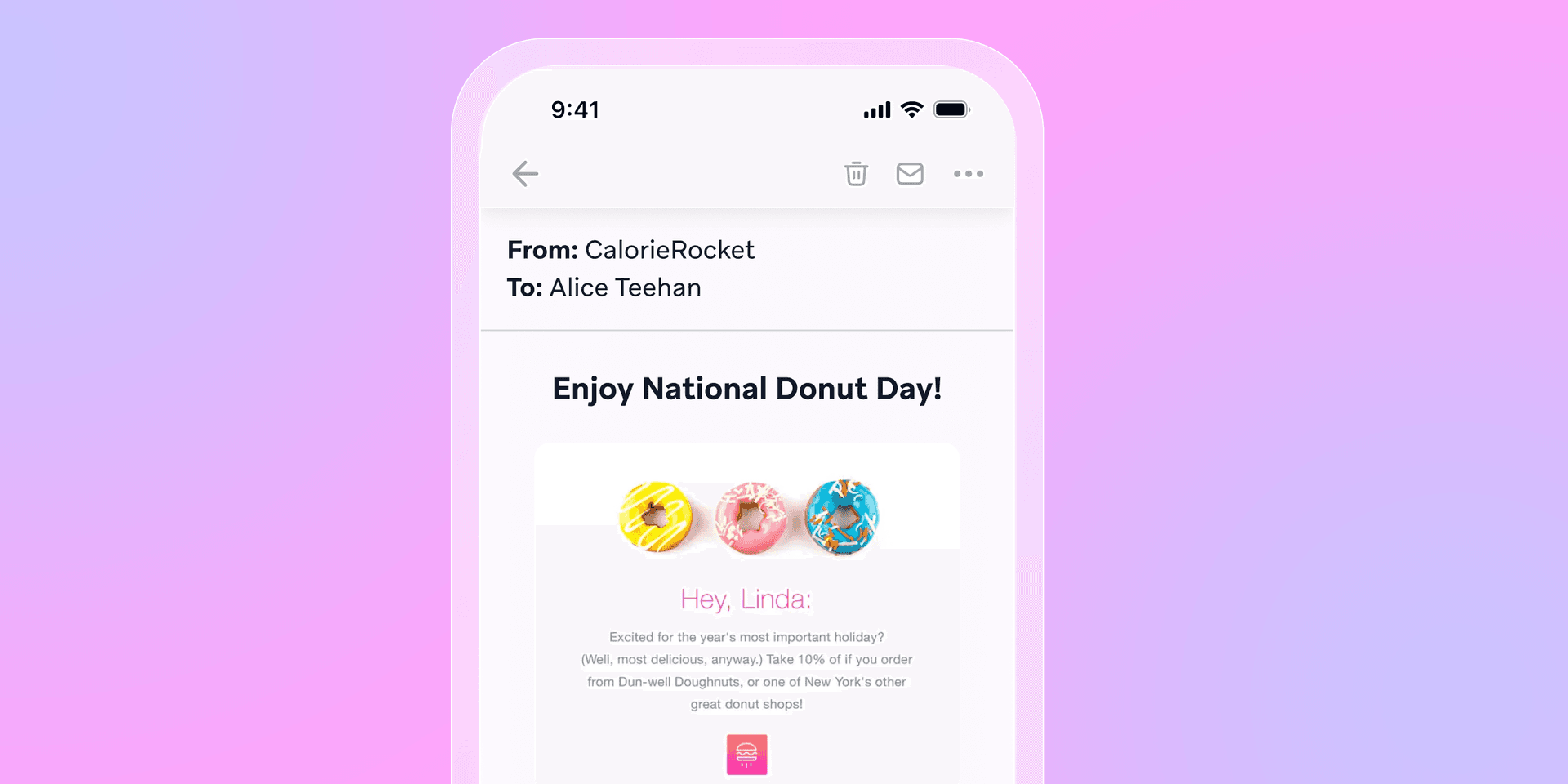
These messages are often sent via text, push, or in-app notifications, but geo-targeting can also influence the ads you see when you open a social platform or visit a website. Paired with customer data, like preferences and past activity, geo-targeting helps you connect with the right people at the right moment, while avoiding those who aren’t a fit.
How it works
Geo-targeting, or mobile-location targeting, typically uses a device’s IP address to determine location. Every internet-connected device—phone, tablet, or laptop—has one, with part of the address identifying the country and the rest narrowing down to regions, cities, or even postal codes. This lets marketers reach people in specific locations with precision, wherever their device goes.
You’ve probably seen it in action
If you’ve ever spotted a Facebook ad for a nail salon in your neighborhood instead of one hundreds of miles away, that’s geo-targeting at work, making sure you’re only seeing offers and experiences that are close enough to act on.
2. Geofencing
Geofencing uses a virtual boundary—a defined area marketers set—to trigger messages when someone’s device enters or exits that space. Unlike geo-targeting, which can include or exclude users based on extra data like demographics, geofencing simply captures everyone who crosses into the zone. It’s especially useful for catching customers’ attention in the moment, such as when they’re walking past a store or attending an event.
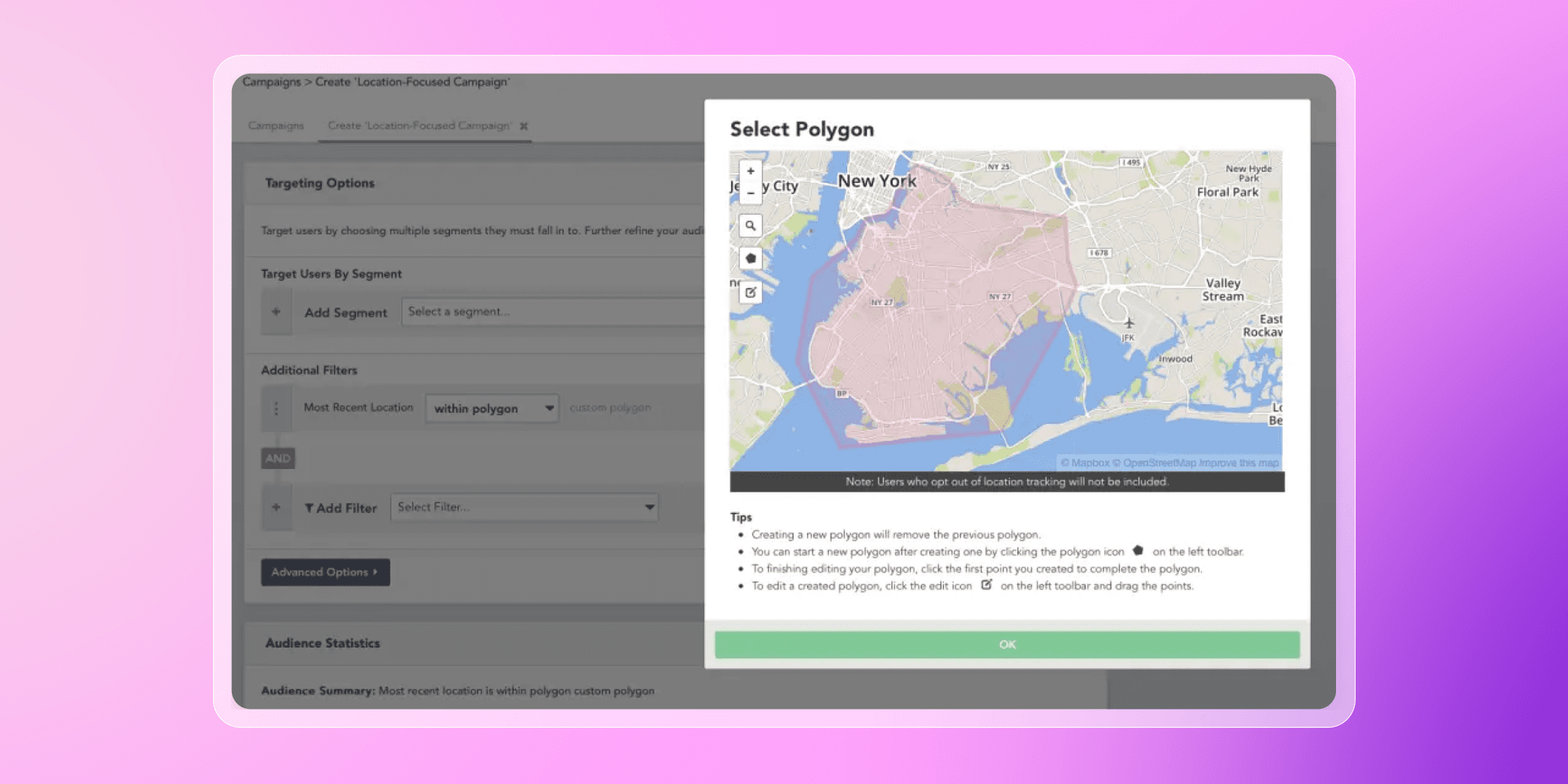
How it works
Geofencing typically relies on GPS to map a digital perimeter. When a device moves into or out of that perimeter, it triggers an automated message, such as a push notification or SMS, as long as the person has opted in to that channel.
You’ve probably seen it in action
If you’ve ever been at a concert and received a push notification to grab merch while you’re still in the venue, or set a reminder on your phone to pick up something when you’re near a shop, you’ve experienced geofencing in action.
3. Beacons
Beacons are small, low-cost Bluetooth devices—usually under two square inches—that detect nearby smartphones and trigger location-based messages. The beacons themselves don’t send the content. Instead, they signal a server, which can then send a push, SMS, or in-app message, depending on the campaign setup.
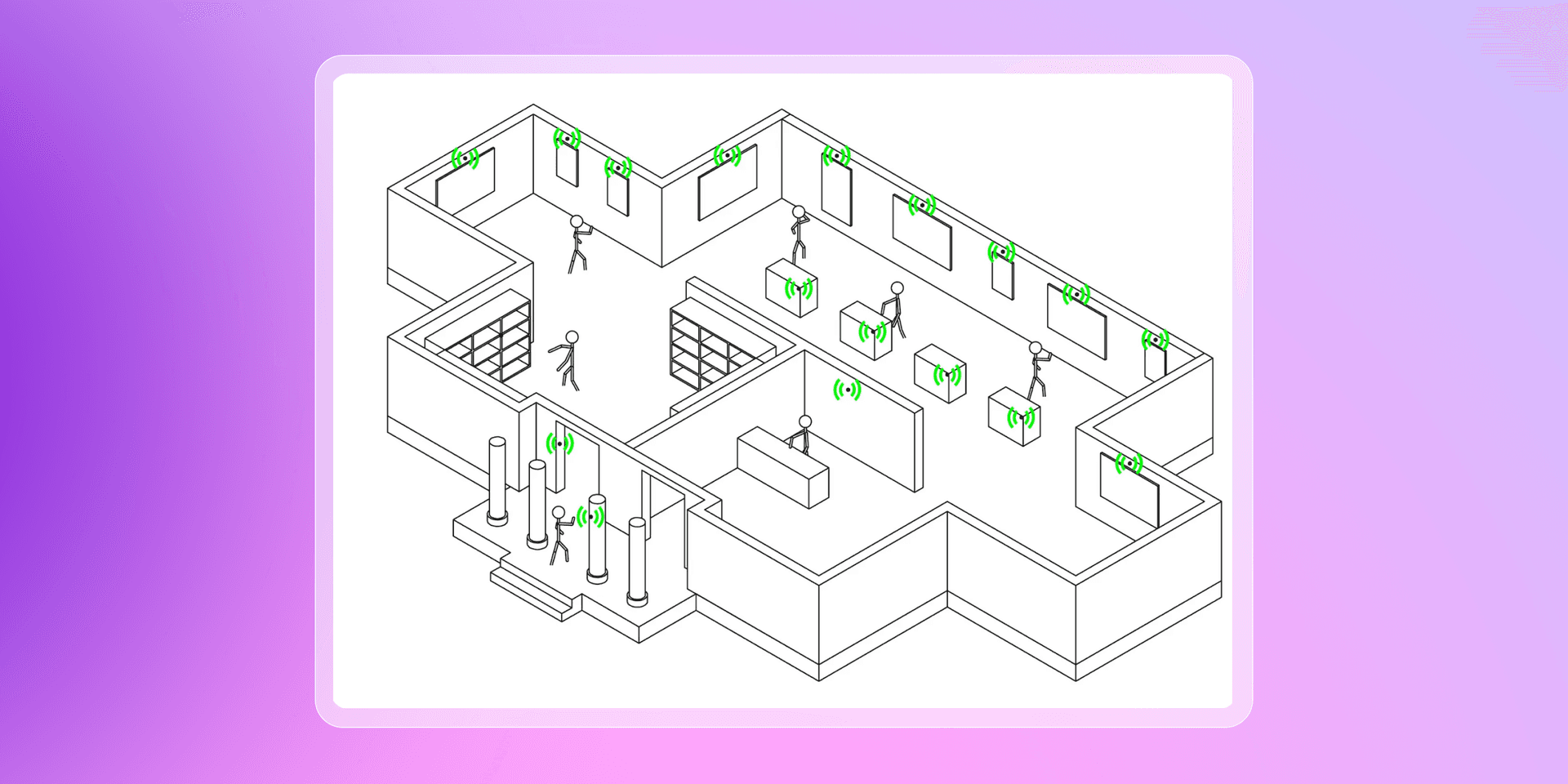
How it works
This type of proximity marketing uses Bluetooth Low Energy (BLE) technology, which is inexpensive, works without Wi-Fi or strong cell service, and uses very little power, so batteries can last for months or even years. The trade-off is that users must have Bluetooth turned on and have granted the necessary permissions to receive beacon-triggered messages.
You’ve probably seen it in action
If you’ve walked into a store with that brand’s app installed and received a notification about an in-store deal, or been prompted to donate to a cause while attending a live event, there’s a good chance a beacon was behind it.
4. Data enrichment
Data enrichment combines your own first-party customer data with third-party context—like local weather, upcoming events, or real-time foot traffic patterns—to create more precise and timely outreach. By layering these additional signals onto location data, brands can adapt messaging to reflect what’s happening in a customer’s immediate environment.
How it works
Data enrichment typically integrates with location services to pull in relevant external factors. This could mean syncing with weather APIs to promote cold-weather products during a cold snap, or using event calendars to reach attendees as they arrive at a venue.
You’ve probably seen it in action
Ibotta, in partnership with Braze and Radar, used data enrichment to send personalized offers right at the point of purchase, increasing redemption rates by reaching customers at exactly the right moment.
5. Language-based personalization
Language-based personalization adjusts the language, tone, and regional references in your messaging based on a customer’s location. This not only improves clarity but also strengthens the sense of connection between brand and audience.
How it works
When a user’s location is identified, messaging is localized to match their preferred or most relevant language. This can include full translations, regional spelling and phrasing, or localized cultural references to make campaigns feel native to the recipient.
You’ve probably seen it in action
Canva localizes campaigns into 20 languages and tailors send times based on user locations. This approach has increased open rates by 33% and boosted engagement by 2.5%.
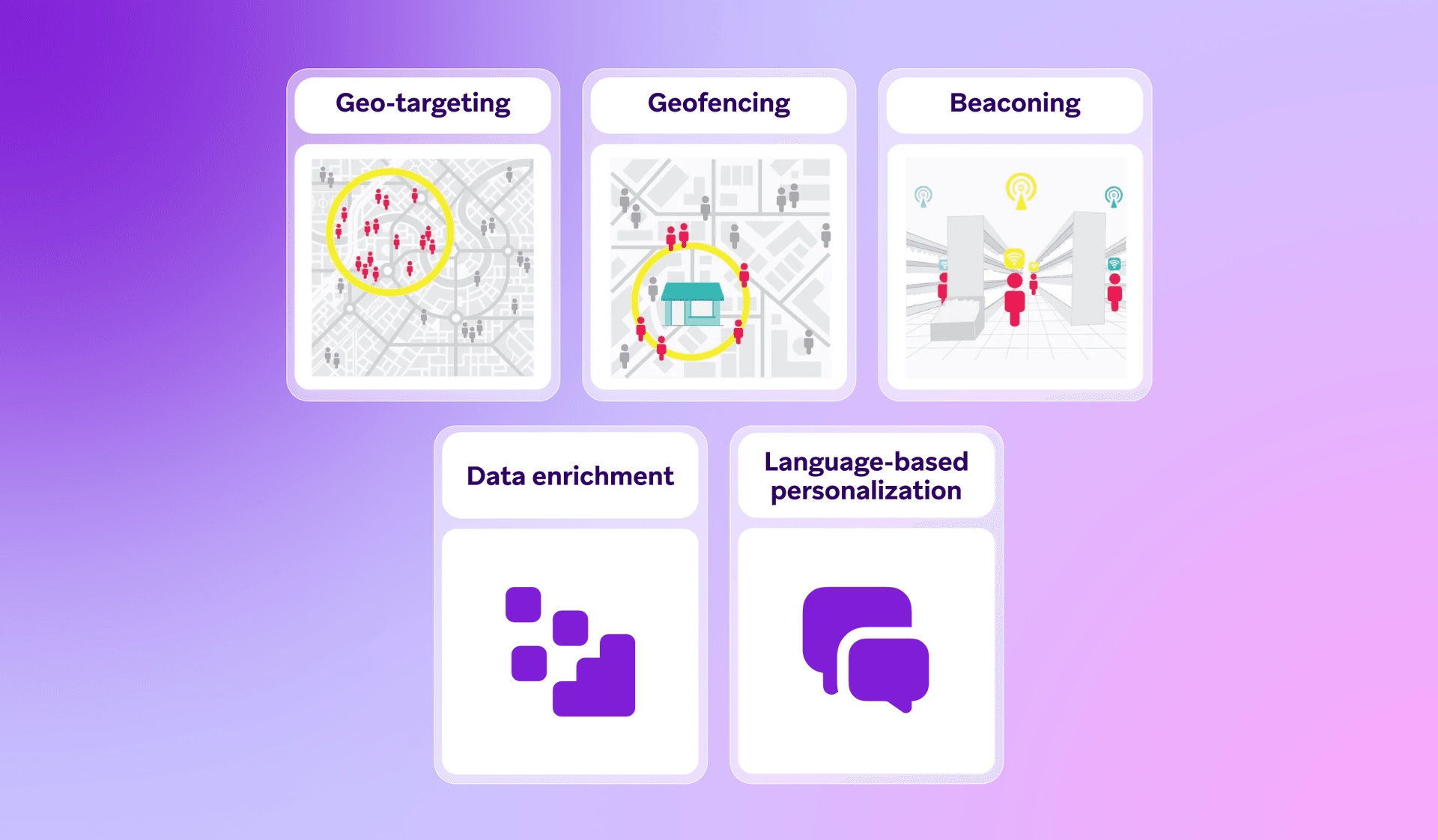
Types of location data
The way you collect location information determines how you can use it. Most location-based marketing falls into one of three data categories:
Static data
Fixed information like mailing addresses, postal codes, or self-reported city/country. Useful for broad segmentation (e.g., sending winter coat promos to colder regions), but not for real-time triggers.
Foreground data
Gathered while a user’s app is open (“in the foreground”), often via GPS or Wi-Fi. More precise than static data and updates during active sessions, making it ideal for timely but session-linked campaigns.
Background data
Collected even when the app isn’t open, with user consent. Enables real-time triggers like geofencing or beacon campaigns. Powerful for timely engagement, but requires careful handling to avoid overstepping on privacy or frequency.
How location-based marketing works in practice
An effective location-based marketing or location based advertising campaign typically follows these steps:
- Identify target location(s) – Define the geographic areas you want to focus on, whether broad regions or hyperlocal zones.
- Segment your audience – Build groups of customers currently in those locations, using real-time data.
- Craft location-relevant messages – Tailor offers, alerts, or content to the local context, such as nearby store promotions or weather-specific recommendations.
- Select delivery channels – Reach audiences via push notifications, in-app messages, email, or SMS.
- Gather and use consent – Customers must opt in to location tracking; explain the value clearly during onboarding or through in-app prompts.
- Account for data gaps – If you don’t have a customer’s location, they won’t receive the campaign; the same applies if they haven’t opted in to the chosen channel.
Benefits of location-based marketing for customer engagement
As consumer attention becomes harder to earn and competition grows fiercer, broad, generic campaigns are easy for customers to ignore. The right types of hyperlocal marketing can flip that challenge by letting brands concentrate on the audiences and moments that matter most—turning proximity into an advantage.
1. Higher conversion rates through relevance
Personalization based on location can boost conversions by up to 27%. Campaigns timed and tailored to a customer’s real-world context are far more likely to inspire action.
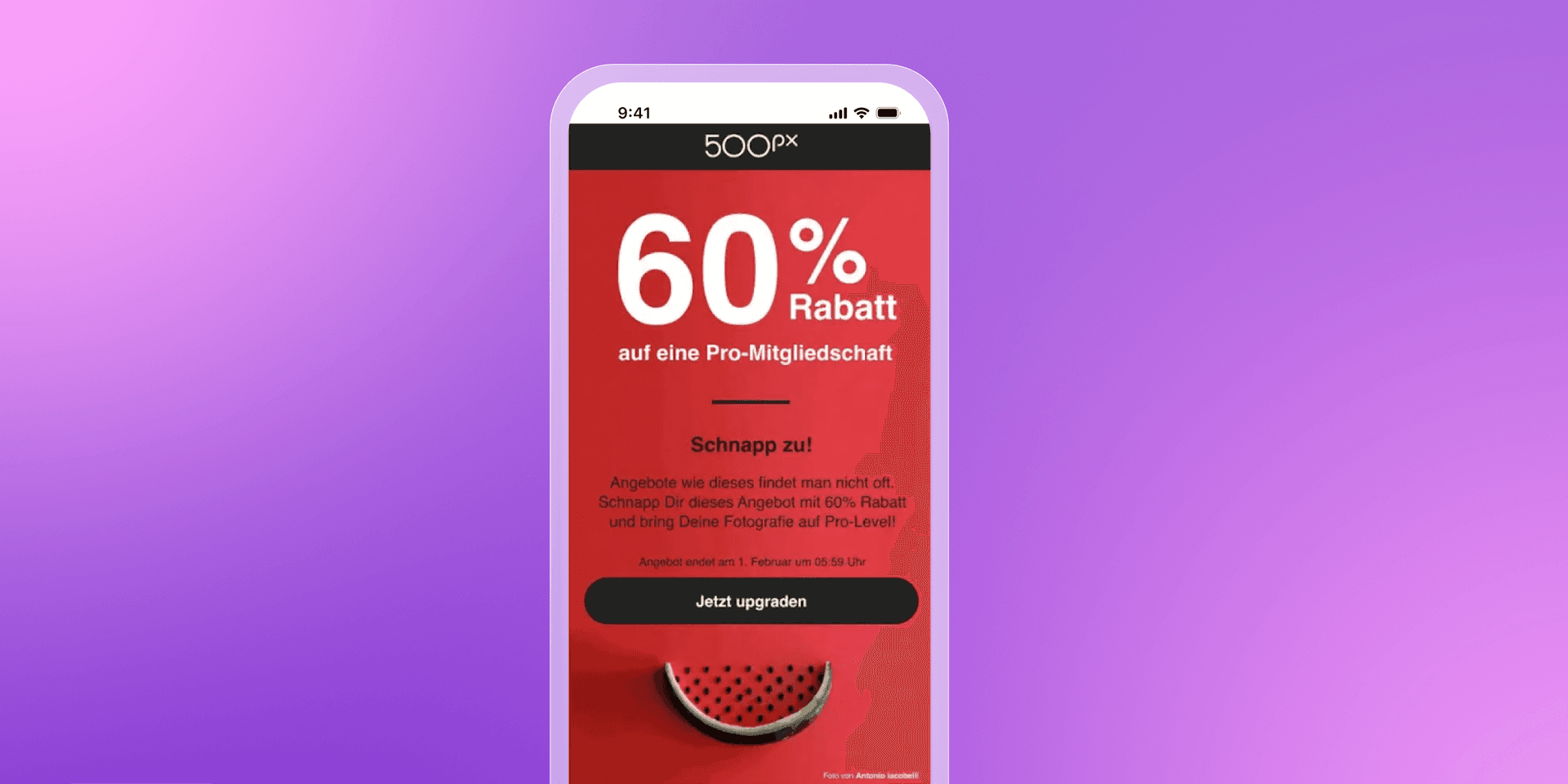
Example: 500px used built-in language targeting in Braze to send promotional emails and in-app messages in German and French, tailoring campaigns to local audiences. This drove a 257% revenue increase in Germany and a 145% increase in France, with Germany becoming one of their top three markets within months.
2. Boosted engagement and retention
Geo-triggered messaging speaks to customers’ immediate context, cutting through the noise and encouraging repeat interactions.
Example: Burger King’s Whopper Detour campaign geofenced 14,000 McDonald’s locations, offering a one-cent Whopper when users opened the Burger King app nearby. The result: 3.2 million app downloads and a 50% lift in monthly active users.
3. Localized brand experiences that build loyalty
Tailoring campaigns to match a customer’s environment shows the brand understands and values their day-to-day reality.
Example: Canva used Braze to run campaigns in 20 languages, personalizing both timing and content. This approach increased open rates by 33% and engagement by 2.5%.
4. Event-based engagement at scale
Location data can enhance live experiences and drive participation during key moments.
Example: Zac Brown Band used Bluetooth beacons in Wrigley Field to trigger in-app charity donation prompts mid-concert, boosting real-time engagement and contributions.
Real-world examples of location-based advertising campaigns
The real magic of location-based advertising is in how brands use it to surprise, delight, and connect with people in ways that feel effortless. These campaigns show what happens when timing, context, and creativity line up perfectly.
Fast food, faster thinking: Burger King’s Whopper Detour
Burger King, a global quick-service restaurant (QSR) brand, set out to strengthen relationships with diners and boost mobile app usage by embracing creative, mobile‑first customer engagement.
The challenge
In a crowded QSR market, traditional ads and promotions were table stakes. Burger King needed a breakthrough approach to grow app adoption and engagement at scale.

The strategy
The team launched Whopper Detour, turning 14,000 McDonald’s locations into promotional zones with geofencing. Using Braze with location partner Radar, the brand encouraged users in‑app to enable location and notifications, then delivered timely push notifications, in‑app messages, and email the moment someone was within 600 feet of a McDonald’s to unlock the deal for a one‑cent Whopper. Braze testing capabilities helped optimize opt‑ins and message performance.
The results
- 3.2 million new app installs
- 53.7% lift in MAUs,
- 143% increase in users sharing location data
- 37:1 campaign ROI
From Sydney to Stuttgart: Canva’s global connection
Canva, the online design platform serving millions across 190 countries, set out to communicate more effectively with a diverse, global audience.
The challenge
Email and messaging were managed across siloed systems, and most communications went out only in English. The team needed scalable localization without sacrificing deliverability or speed.

The strategy
Using Braze Connected Content with the Google Sheet API, Canva sent tailored messaging in 20 languages, while running an advanced IP warmup to safely scale weekly sends from 30 million to 50 million. Campaigns featured timely, helpful content and were orchestrated across channels to match local needs.
The results
- 33% uplift in open rates
- 2.5% increase in engagement
- 99% deliverability while doubling down on email volumes
Privacy considerations and platform changes in location-based marketing
You can’t discuss location-based marketing without addressing privacy. Concern around the sensitive nature of some data is often the biggest barrier to broader adoption and trust. For both brands and consumers, how personal information is collected, used and protected is of primary importance. Even well-intentioned marketing efforts can feel uncomfortable to customers if done carelessly.
Research found that 55% of people describe it as creepy when websites know their location immediately upon opening—without user consent. 81% used negative descriptors like “scary,” “annoying,” or “invasive” to describe such tracking.
Even well-intentioned campaigns can feel invasive if the value isn’t obvious. If you can’t make a clear, credible case for why sharing location will improve a customer’s experience, it’s better not to use it. And if you do, avoid overusing the data you gain. Triggering a push every time someone walks past your store isn’t just annoying, it’s a fast track to opt-outs.
The tech landscape is also shifting rapidly. Major platforms are rolling out more granular permission settings, tighter background tracking limits, and privacy-preserving APIs that reduce reliance on persistent identifiers. At the same time, regulators are increasing scrutiny on sensitive location data, with enforcement actions targeting companies that collect or share precise information without consent.
For marketers, this means two things:
- Build location-based campaigns on a foundation of clear, customer-first privacy practices—ask for permission at moments of obvious value, explain how data will be used, and avoid sensitive-location targeting.
- Stay agile. Platform rules, privacy tools, and consumer expectations will keep evolving, and strategies need to adapt in step.
When customers know their data is respected, they’re far more likely to share it.
Best practices for implementing location-based marketing
Clear value, respectful data use, and smart execution are what separate successful location-based advertising from campaigns that alienate customers. These best practices can help build programs that perform over time.
1. Ask for consent at the right time
Prompt for location permissions during onboarding or when the value is most obvious. For example, just before offering location-specific offers or local event updates.
2. Be transparent and specific
Explain exactly how location data will be used, what customers will gain, and what won’t be done with their data. Make commitments and honor them.
3. Match technology to the use case
- Geo-targeting for broad audience reach in defined regions.
- Geofencing for contextual triggers around physical locations.
- Beacons for precise in-store or event experiences. Choose based on the customer journey stage and campaign goal.
4. Combine location with other customer data
Layer in behavioral signals, preferences, and lifecycle stage to create richer, more relevant outreach.
5. Monitor KPIs for early warning signs
Track opt-out rates, app uninstalls, and engagement drop-offs to spot issues before they damage trust.
6. Test before scaling
Run A/B or multivariate tests on small segments to validate timing, creative, and targeting accuracy before expanding campaigns.
7. Avoid “creepy” execution
Don’t call out hyper-specific movements in messaging unless the value to the customer is obvious and significant. Keep the focus on helpfulness, not surveillance.
How Braze supports location-based marketing campaigns
Braze enables marketers to activate real-time, location-based targeting across channels with precision and scale. Using a combination of geofences, beacons, and third-party data enrichment, Braze helps brands deliver hyper-relevant messages exactly when and where they matter.
Key capabilities within the Braze platform
- Real-time location triggers – Send push notifications, in-app messages, emails, or SMS the moment a customer enters or exits a defined location.
- Cross-channel orchestration – Combine location signals with behavioral and lifecycle data to trigger personalized flows across multiple channels.
- Audience segmentation – Build dynamic segments based on a user’s current location, past movements, or proximity to specific points of interest.
- Data enrichment – Integrate external context like local weather, events, or traffic to make outreach more relevant.
- Testing and optimization – Run controlled experiments to measure the impact of different targeting strategies before scaling.
- Privacy-first execution – Use built-in permission management and preference centers to maintain transparency and respect for user data.
The flexible architecture of Braze allows marketers to choose the right mix of location-based tactics, from broad geo-targeting to aisle-level beacon triggers, without sacrificing customer trust.
Checklist for location-based marketing success
Before you launch your next campaign, run through this quick checklist to make sure you’re set up for success:
- Define clear objectives – Know whether you’re driving foot traffic, increasing engagement, or boosting conversions.
- Choose the right tactic – Match your goal to the best method: geo-targeting, geofencing, beacons, data enrichment, or language-based personalization.
- Segment with precision – Use real-time and historical location data alongside demographic and behavioral insights.
- Craft relevant creative – Make offers and messages that feel native to the recipient’s location and context.
- Test and iterate – Use A/B testing to optimize timing, copy, and targeting boundaries.
- Ensure compliance and transparency – Get explicit consent, explain how data will be used, and offer easy opt-out.
- Measure results – Track engagement, conversions, and retention tied directly to your location-based triggers.
Final thoughts on location-based marketing
Location-based personalization is powerful, but it’s just one component of successful marketing strategy. The brands that see the biggest lift combine location with preferences, past behavior, and lifecycle stage to make campaigns feel genuinely useful.
That usefulness is what earns trust. Customers are far more willing to share their location if the value is clear and the experience is better because of it. That means asking for permission at the right moments, keeping your promises about how data will be used, and resisting the temptation to overuse data.
As privacy rules tighten and platform controls evolve, the core principle stays the same: be transparent, be relevant, and let location work alongside your other data to create messages that resonate in the moment.
Location-based marketing FAQs
What is location-based marketing?
Location-based marketing tailors messages, offers, or content based on a customer’s real-world location, using GPS, Wi-Fi, IP addresses, or Bluetooth beacons to deliver more relevant experiences.
What are the types of location-based marketing?
There are many types of location-based marketing but the most common include geo-targeting advertising, geofencing, Bluetooth beacons, data enrichment with context like weather or events, and language personalization to suit local audiences.
Be Absolutely Engaging.™
Sign up for regular updates from Braze.
Related Content
View the Blog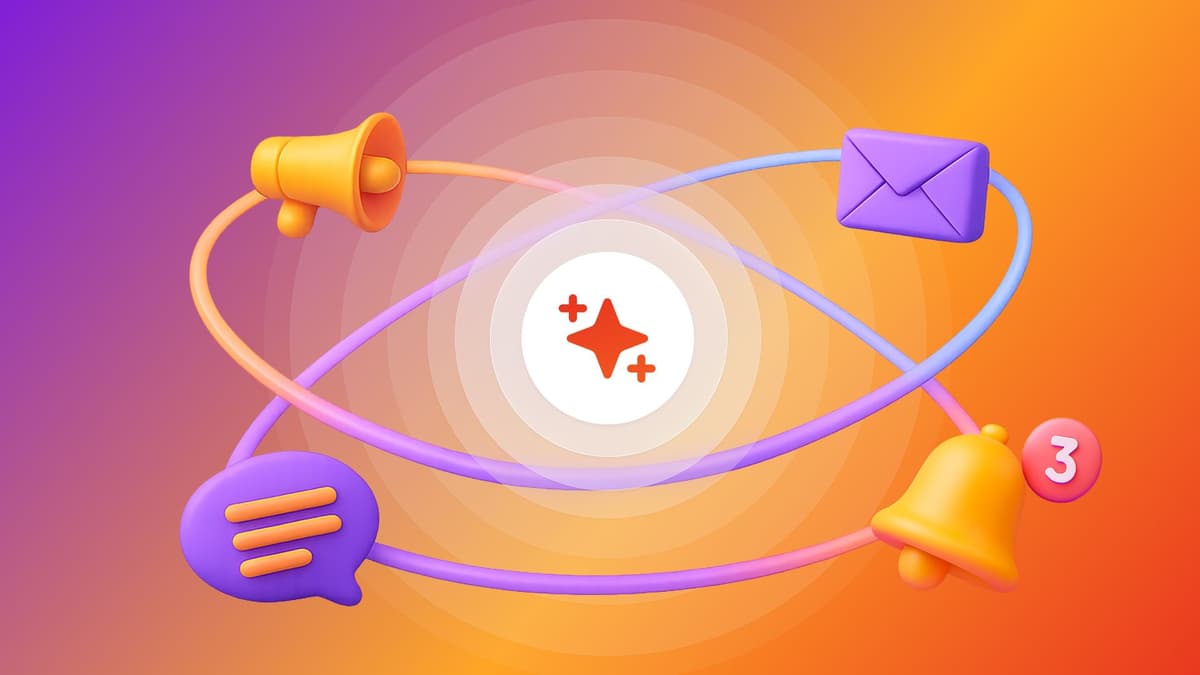
How AI Decisioning Transforms Marketing (A Complete Guide)
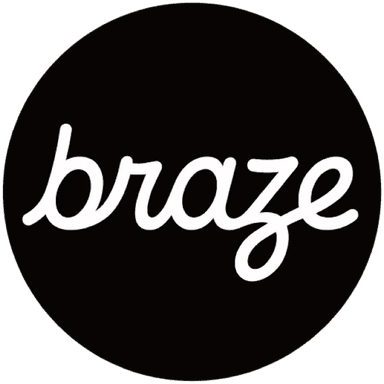
Team Braze

AI decisioning cheat sheet: How to crawl/walk/run with BrazeAI Decisioning Studioᵀᴹ

Team Braze

A day in the life of a data scientist on the BrazeAIᵀᴹ forward-deployed engineering team
